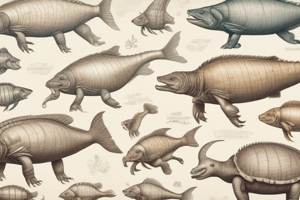Podcast
Questions and Answers
A $5$-legged animal can be classified as an insect.
A $5$-legged animal can be classified as an insect.
False (B)
All birds are able to fly.
All birds are able to fly.
False (B)
Only carnivores can be predators.
Only carnivores can be predators.
False (B)
The food chain always starts with an animal.
The food chain always starts with an animal.
A $4$-legged animal can be classified as a worm.
A $4$-legged animal can be classified as a worm.
Flashcards
Vertebrates
Vertebrates
Animals with a backbone, such as mammals and birds.
Carnivores
Carnivores
Animals that eat only meat, like lions and eagles.
Invertebrates
Invertebrates
Animals without a backbone, including insects and spiders.
Predator
Predator
Signup and view all the flashcards
Food Chain
Food Chain
Signup and view all the flashcards
Study Notes
Animal Grouping
- Animals are grouped by features, food, and movement
- Animals are categorized into vertebrates (with backbones) and invertebrates (without backbones)
Vertebrates
- Fish live in water
- Amphibians live on land and in water
- Reptiles move by creeping or crawling
- Birds have wings, feathers, and beaks; some can fly
- Mammals feed their young with milk and give birth to live young
Invertebrates
- Worms have long, soft bodies
- Spiders have eight legs
- Insects have six legs, often wings, and three body parts (head, thorax, abdomen)
Animal Feeding Groups
- Carnivores eat only meat
- Herbivores eat only plants
- Omnivores eat both meat and plants
- Insectivores eat only insects
Animal Movement
- Animals use their legs for running, climbing, and crawling
- Animals use their wings for flying
- Animals use their fins for swimming
- Animals use their bodies for crawling and creeping
- Animals use their arms and legs for climbing, swinging, walking, and running
Food Chains
- A food chain shows how living things get food and energy passes from one to another, starting with plants and ending with animals
Predator-Prey Relationships
- Predators hunt other animals for food
- Prey are hunted by predators for food
Studying That Suits You
Use AI to generate personalized quizzes and flashcards to suit your learning preferences.




